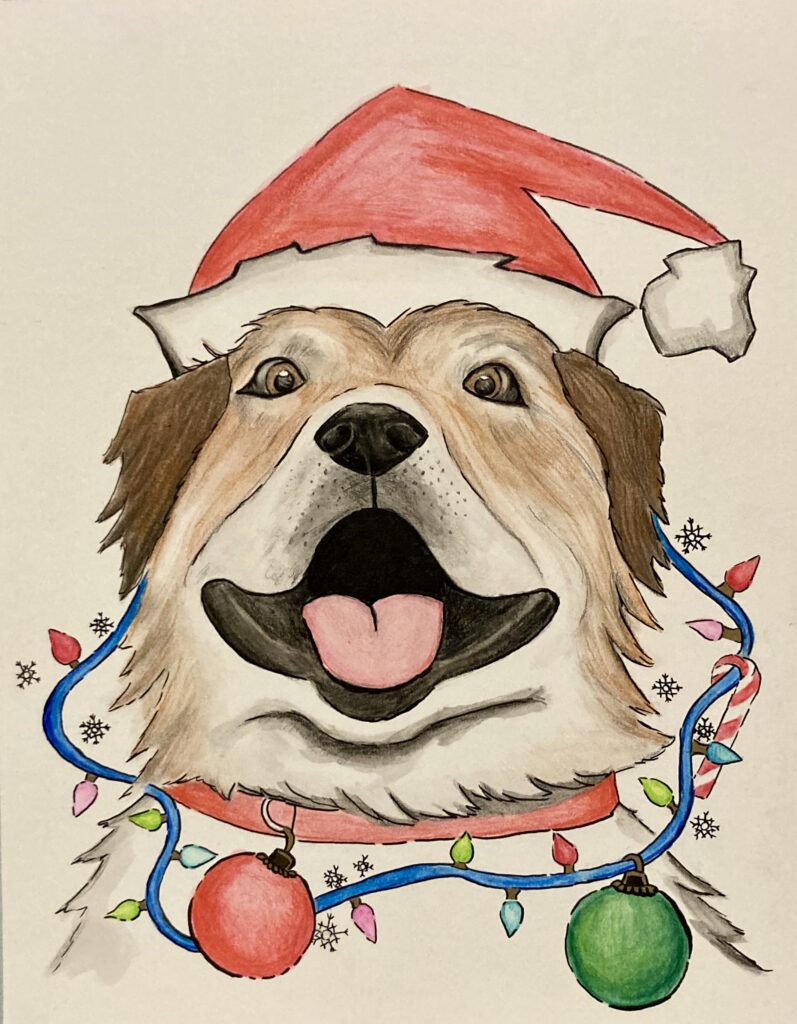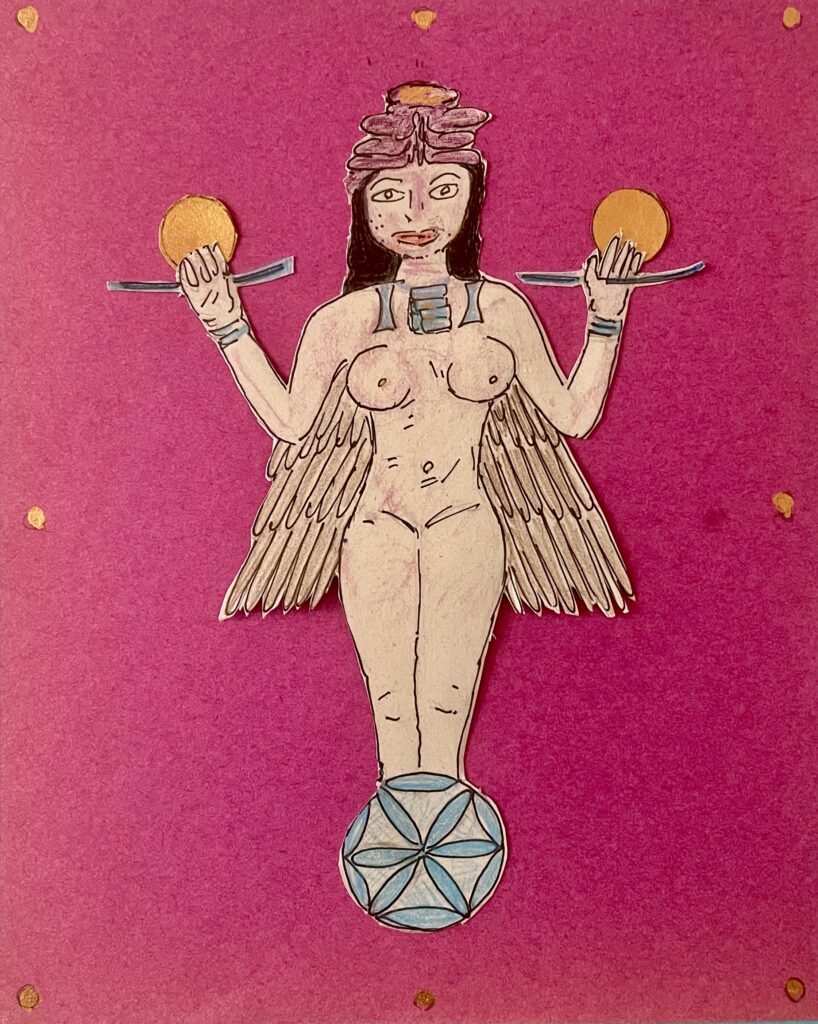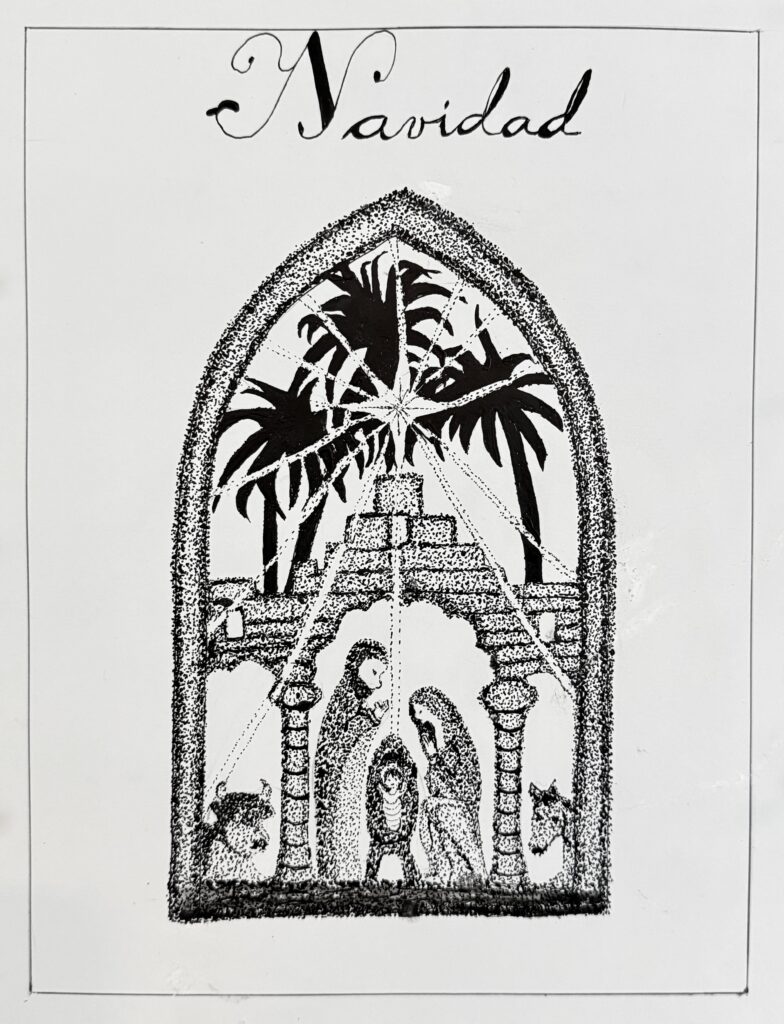
Irena Kaci
After the gourds have been cleared off of porches, and the comically exaggerated cobwebs have been swept back into buckets to wait until next fall, the turn toward Holiday season begins. In a city as large as Worcester this means many different things to many different people. And even though, twinkle lights make an appearance in many windows, and elaborate Xmas or Hanukkah themed displays usually dominate, they by no means exhaust all the ways in which winter holidays are observed across the city.

To shed some light into these traditions and the staggering variety that constitutes our strength, Art Professor at Worcester State University, Brad Chapman has invited all the students in his Intro to Illustration class to use their artistic prowess and tell of their holiday spirit. Chapman has been a professor of Visual Art in the Worcester State Visual and Performing Arts Department for almost three years now. After finishing his Master’s at Goddard College, Chapman has made himself at home here at Worcester State as both undergraduate instructor as well as curator of the Mary Cosgrove Dolphin Gallery inside the University. The gallery, which is open Wednesday-Friday from 11am-5pm and Saturday from 1-5pm cycles through almost eight shows a year.


The Course Intro to Illustration “serves as an introduction to the processes involved in illustration. This may include, but is not limited to editorial illustration, children’s books, book/album covers, concert posters, comics/manga, character design, botanical illustration, medical illustration and basic lettering.” The course covers illustration techniques in painting and drawing. An illustration is a ‘visual composition made by an artist to explain information’. Chapman further explains the concept of this particular class. “This can come in the form of a drawing, painting, photograph, collage, etc. as long as it supports the text that accompanies it, visually representing details and/or facts. An illustration is different from a typical piece of art. While an illustration’s purpose is to explain something visually, fine artworks, such as paintings, are not necessarily connected to specific information and are always subject to interpretation. Illustration is essentially a combination of fine-art, design and advertising. An illustrator’s artistic skills are utilized to convey ideas, narrate stories, and enhance the visual appeal of projects.”

Chapman maintains that having a good foundation upon which to build artistic skill is very important, however he values artistic voice just as much. “ To me, however, developing your own artistic voice and personal style of artmaking is invaluable. The key to creating a successful illustration is being able to say what you need to say, simply and efficiently, in your own unique visual language. We all see the world and interpret information differently; being able to make artwork that captures your personal way of seeing often helps push the narrative you are trying to illustrate. Learn to trust and enjoy the process; let go of your attachments to any particular outcome. In doing so, opportunities for discovery of new knowledge arise. Be present and mindful, allow yourself to make mistakes and experiment. Direct your thoughts and ideas toward benefiting your life inside and outside of making art!”

Grace Errara, a senior in Business Administration, is quick to discuss how the holidays make her feel. “ When I think of the holidays, I am reminded of warmth, coziness, nature, and family. To capture this, I have two individuals sitting in front of a fireplace, looking down as they laugh and converse in the warmth. My family ends up gathered around the fire many nights, as we listen to music, talking and laughing about random stories. My mother and I typically decorate the mantel with pine and berries we’ve gathered from the backyard, along with lights and small decorations. I wanted to include this aspect to represent the nature vibe that I am reminded of during the holiday season.”

Bryan Thongphala, an Art Major in his second year, calls his piece Christmas Night Out, and he describes his view on the holiday season as follows: “Bars can be a lonely experience, but sometimes it can be a safe haven for those who don’t have anyone to celebrate Christmas with. A place where people can gather regardless of background and knock back a few drinks together.”

Aeshah Nadeem, a third year in Liberal Studies Major, had this to say about her process: “I think that part of what makes a holiday “a holiday” is being able to celebrate it with family and relatives. After being away from my country for eight years, I was finally able to go back and celebrate with my family. The piece I painted shows my cousin’s hand pointing at my hands
holding the money my grandmother gave me as part of a tradition we have during holidays, where older people give younger people money instead of gifts.”

Cynthia Nute, another Art Major, talks about her view of Christmas as a Christian tradition: “Christmas traditions, gift giving, tree trimming, and the gathering of friends, bring a feeling of nostalgia. These traditions continue to be observed from generation to generation without considering what it is we celebrate. The first Christmas, the birth of Christ, was a Christian holiday observed to celebrate the coming of their promised Messiah. Today, the humble story of a baby born in a feeding trough to a virgin girl – God incarnate, is lost to the imagery of a tree trimmed with lights, gold, corn and cranberry. Overindulgence of consumerism packed under its branches with a promise to bring contentment. All the while, sorrow is compounded for many who feel the weight of it all. The true representation of the tree of Christmas is weathered by storm and loss. Its branches broken, pruned. At a first glance it holds no appearance that would attract one to gaze upon it, yet its promise of contentment and life is eternal green. Its ultimate purpose fashioned for the cross.”

Libia Goncalves, yet another transplant to Worcester describes what Christmas traditions look like in Colombia. “Christmas traditions are deeply entwined with the country’s rich Catholic heritage, and the way Colombians celebrate this time of year is filled with joy, and devotion. It begins on December 8th with the Feast of Light,
celebrating the Immaculate Conception of Virgin Mary and the preparation for the birth of Baby Jesus. Cities, towns, and neighborhoods light up with beautiful displays of lights and decorations.. These traditions help bring the entire community together and offer a sense of anticipation, reverence, and hope during the Advent season.”
Special significance during the season is given to the Nativity Scene. Goncalves continues to elaborate: “ One of the most cherished customs in Colombia during Christmas is the creation of the nacimiento, or Nativity scene. Families, towns, and cities across the country take great care in constructing these elaborate displays, which depict the birth of Jesus Christ in a humble stable in Bethlehem. The nacimiento includes not just the Holy Family—Jesus, Mary, and Joseph—but also a range of other figures like shepherds, angels, animals, the three wise men, and often various villagers, reflecting a sense of community in the birth of Christ. The figures are often displayed in elaborate settings like mountains, rivers, and villages that mimic the landscapes of Colombia, making the scene more personal and meaningful..”
Given the very important role of religion in the tradition there is also something to be said about the nine days of prayer, or the Novena. “ In the nine days leading up to Christmas Eve, Colombians traditionally participate in the Novena de
Aguinaldos (Christmas Novena), a deeply cherished and spiritually significant custom. The Novena consists of nine days of prayer, starting on December 16th and concluding on December 24th, Christmas Eve, the night baby Jesus delivers the presents for all. Children are often involved in dramatizing the Nativity story. The Novena serves as a time of spiritual preparation for the Christmas celebration, emphasizing patience, faith, and a sense of anticipation for the coming of Christ.”
Family and community is another tremendously important aspect of the Holidays in Colombia. “Christmas is not just a time for religious observance, but also a time for strengthening family and community bonds. Through customs like building the nacimiento, lighting the streets in the Feast of Lights, honoring the Virgin Mary on the Immaculate Conception, and participating in the Novena, Colombians prepare
themselves spiritually and emotionally for the birth of Jesus. These traditions enrich the holiday season, fostering a deep sense of connection to one’s faith, family, and fellow community members, and ensuring that the true meaning of Christmas remains alive in the hearts of all.”

Getting her second Bachelor’s in Art at Worcester State Mary Holmes takes another view: “ Regardless of race, creed, religion, etc.. Everyone is part of the holidays But, being in the season, doesn’t mean everyone participates in the same way.
This illustration celebrates and acknowledges some of the different ways people spend December in the US.”

Poland born Natalia Blazejewski, is working on an illustration of a cat playing with some Christmas Decorations hanging from the tree. Blazejewski’s two cats were the inspiration for the artwork. She is quick to explain that her whole family lives in Poland and each year, her Grandmother makes her an ornament made of yarn, like the snowflake depicted in her illustration. Foods like Carp and Pierogies did not make it into the artwork, though they are still very traditional at Holiday time.

Donna Church who did the piece, Holiday Images
“I chose simple line drawings of winter holiday symbols because my family celebrates on a secular basis the events of Winter Solstice, Christmas and Chanukka. For me, this is a personal time of peace and family and of concern for the Earth and its creatures. It’s quiet. The light from candles, used by so many traditions, light the dark of the longest nights and bring comfort and hope for brighter days and harmony between humanity and nature.”
The world is as diverse as it is vast and Worcester encompasses so many different cultures. Wielding this diversity as a magnifying glass in order to learn and appreciate global/local cultures is a fantastic teaching strategy, especially when it comes to artistic expression. Chapman’s Intro to Illustrations class projects wrapped up at the end of the semester, just in time for students to put some of their well defined ideas about what it means to celebrate the warmest season, into practice.

As Brad Chapman Bleau concludes,
“The course focused not only on the individual creative process of developing personal style and artistic voice, but the collaborative process as well. Illustration in and of itself is collaborative, as the artist and client work together to bring an idea to fruition. I thought it prudent to create an assignment that directly works with a publication, unique to Worcester and flexible and willing enough to work with us. PULSE magazine came through!
I was interested in seeing what the holidays look like through the unique lenses of each individual in the classroom. The class is so diverse in culture, age, and ways of life, I knew that no two illustrations would be alike. No two experiences were alike. Everyone views the holidays differently. For some, they are filled with joy and peace, others are filled with sadness and grief. The holidays tend to stir up emotions and feelings that may not quite bubble to the surface the rest of the year. I ask a lot of my students; to dig deep and search within themselves for meaning in the seemingly meaningless. I am grateful for their willingness to be vulnerable and share their deeply personal experiences with not only myself, but all the PULSE readers. So thank you to my students, for the effort and all of the wonderful work you’ve created this year. Keep experimenting, keep creating, keep doing weird things just to see how they make you feel.”






